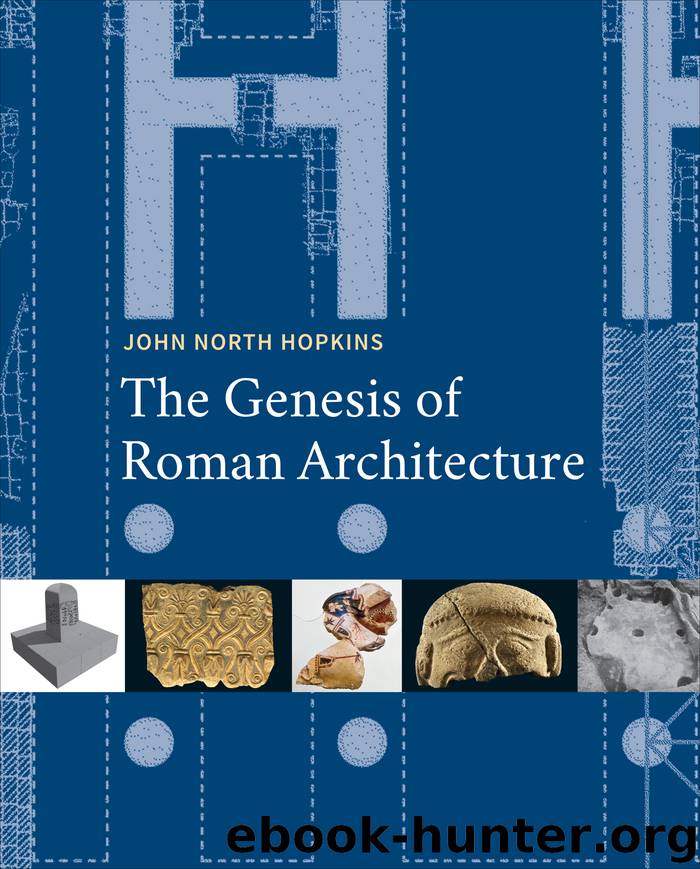The Genesis of Roman Architecture by John North Hopkins

Author:John North Hopkins
Language: eng
Format: epub
Publisher: Yale University Press
Published: 2016-07-25T16:00:00+00:00
THE THRESHOLD OF REPUBLIC
Toward the end of the period, at the end of the sixth century and into the fifth, things begin to change. The primary reason one can begin to find credible connections between text and archaeology is the longevity of the new architecture. Until the very end of the regal period, nearly every work of architecture was built and then destroyed, leaving no imprint on the landscape and therefore no hope of visibility or direct connection to those who wrote Rome’s history. In contrast, many late archaic monuments did endure for centuries, and this allowed the accumulation of archaeological (including epigraphic) evidence of their functions and meanings, down to the appearance of a more trustworthy textual narrative in the middle and late Republic. In some cases, as with the Temple of Castor or the Temple of Jupiter, buildings stood through the middle to late Republic, when texts can corroborate their function and/or design.36 In other cases—for example, with the Area of Vesta or the monumental twin temples of Fortuna and Mater Matuta—archaeological evidence from subsequent centuries of use is enough to attest to a structure’s ongoing function as a sanctuary to the same god or goddess. The Regia built at the end of the sixth century endured until the third century, when both plentiful archaeological evidence and some corroborative textual testimony of its function arise. In a similar way, the houses along the Palatine north slope stood for a few hundred years with only minor refurbishments, and finds from their long use help identify them as well-maintained elite residences.37 Thus, beginning ca. 540/530, many spaces are more clearly identifiable, and from that time, one can feel some real security in speaking of the Comitium, Atrium Vestae, Temple of Jupiter, and other buildings with their proper names and with some correspondence with texts.
This clarity has led some scholars to feel comfortable tying the re/creation of these spaces to political events and to the purported intentions of those who were at the head of the waning monarchy or the new Republic when they were built. Although one is on more solid ground at this point, caution is still essential. It is one thing to recognize that the archaeological date for the Temple of Jupiter coincides with the date given in ancient textual sources; to acknowledge that its image matches these sources’ description and location of it; and, based on a broad scholarly consensus, to uphold that the cult of Jupiter, Juno, and Minerva existed in this archaic building. In this situation, archaeology is confirming a textual record that looked to the structure itself, which existed just decades prior to an author’s birth, and where abundant records bore witness to a religious institution. It is another thing to suggest that the temple was commissioned by Tarquinius Superbus for reasons extrapolated from those sources. In this kind of argument, one is putting faith in annalists and their successors, each of whom relied on testimony about people and ephemeral actions that occurred nearly a half millennium prior.
Download
This site does not store any files on its server. We only index and link to content provided by other sites. Please contact the content providers to delete copyright contents if any and email us, we'll remove relevant links or contents immediately.
Kathy Andrews Collection by Kathy Andrews(11730)
The remains of the day by Kazuo Ishiguro(8822)
Paper Towns by Green John(5091)
Spare by Prince Harry The Duke of Sussex(5072)
Industrial Automation from Scratch: A hands-on guide to using sensors, actuators, PLCs, HMIs, and SCADA to automate industrial processes by Olushola Akande(4981)
The Body: A Guide for Occupants by Bill Bryson(4974)
Machine Learning at Scale with H2O by Gregory Keys | David Whiting(4182)
Be in a Treehouse by Pete Nelson(3948)
Never by Ken Follett(3791)
Harry Potter and the Goblet Of Fire by J.K. Rowling(3774)
Goodbye Paradise(3728)
Into Thin Air by Jon Krakauer(3313)
The Remains of the Day by Kazuo Ishiguro(3293)
The Cellar by Natasha Preston(3262)
The Genius of Japanese Carpentry by Azby Brown(3224)
Fairy Tale by Stephen King(3220)
120 Days of Sodom by Marquis de Sade(3180)
The Man Who Died Twice by Richard Osman(2997)
Drawing Shortcuts: Developing Quick Drawing Skills Using Today's Technology by Leggitt Jim(2996)
